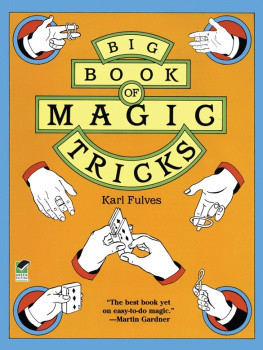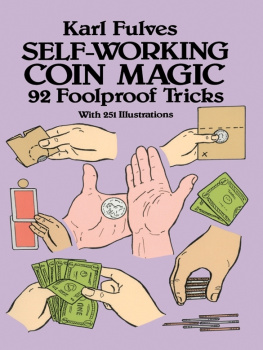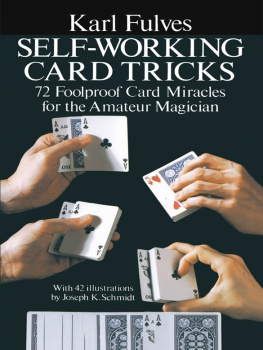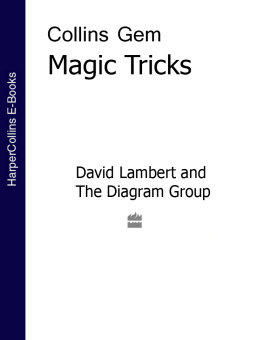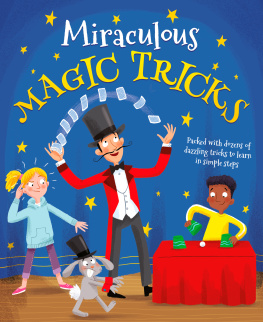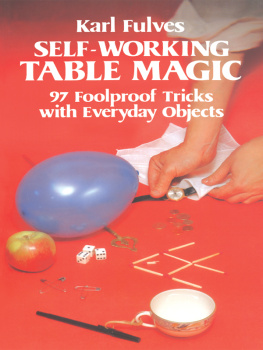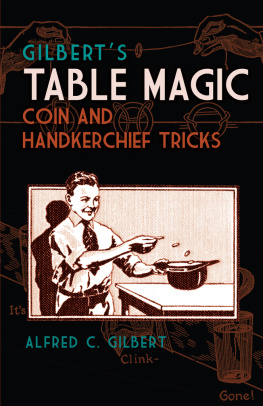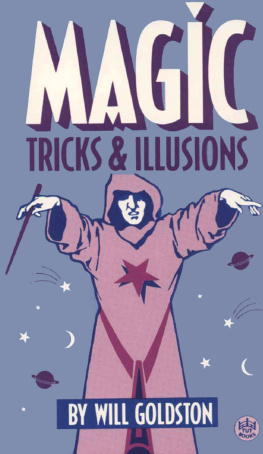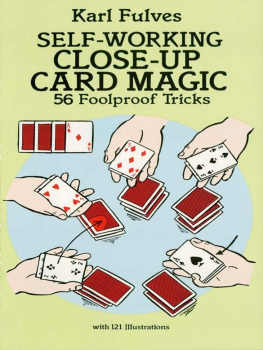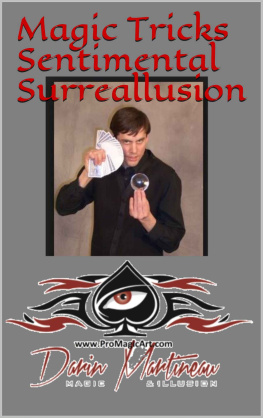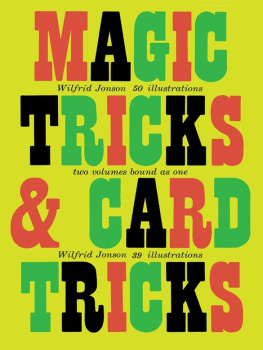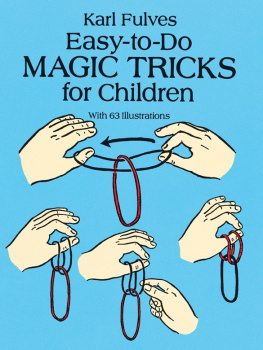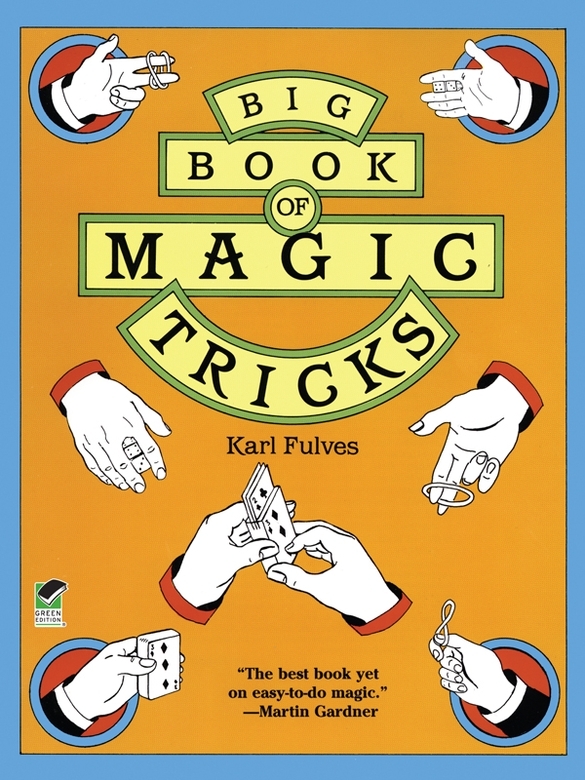The Hilliard quote that opens chapter one of this book is taken from his monumental thousand-page tome Greater Magic. The Hilliard book, Evanss The Old and the New Magic, Christophers Panorama of Magic, and a number of standard reference works were used in the construction of the first chapter. It should be emphasized that many questions about the evolution of magic remain unanswered. It is not the purpose of this book to settle all of the historic puzzles, from Egyptian wall paintings to the true nature of Pinettis rivalry with Torrini, but merely to relate, in somewhat condensed form, what appear to be the best-known facts in these areas.
Allan Slaight originally suggested the tie-in between Build Down and the follow-up gambling routine The Ten-Card Deal. The version of the deal described in chapter nine was based on a stratagem devised by Daniel Dobson.
A trick similar to Scarnes Card Through Glass in chapter ten was developed by Bob Hummer and appeared in print some years ago.
Some tricks in this book appear without credit to particular magicians. In most cases it is because the basic effects and methods are known, but their authors are unknown. In some cases the routines are my own; my name does not appear because I could find no good reason to parade my own name through the pages of this book.
The most difficult items to trace were bets and techniques that are associated with gambling. The perimeter of secrecy that surrounds magic is as nothing compared to the private fraternity of professional gamblers who shun publicity of any kind. Thus, although a particular bet or gambling hustle may be known, its author is almost always permanently unknown.
For their assistance in the preparation of this book I would like to thank Sam Schwartz, Martin Gardner, and Joseph K. Schmidt. Richard McDonough was most generous in allowing me complete freedom in choosing the structure and content of this book.
The Art of the Impossible
In the Beginning, there was magic in the world. There was the magic of day and night, of wind and clouds and of the tides, which were alive and moved at the thunderbidding of unknown gods.
And there was the magic of birth and of life and the disturbing, impenetrable magic of death.
And to the first people, who had come down out of primeval trees to crouch in caves against long nights of fear, everything was magic. Some of it was white magic and good, but mostly it was black magic and bad.
And so they called upon their priests and wizards, who wrought magic charms and incantations against the terrors of death and darkness, thunder and lightning, blood and destruction, and fabricated rude talismans and amulets to placate the unknown gods.... That was in the Beginning.
JOHN NORTHERN HILLIARD
M agic probably began in the time of primitive cave dwellers. Magicians claimed the power of the supernatural power to control the darkness and the unseen spirits that inhabited the night. Magicians stood between cave dwellers and primitive mans fear of the unknown, and because of this, praises were sung to the early magicians, and privileges granted to them.
The earliest written record of a magical performance is found in the Westcar papyrus and tells of the feats of the magician Dedi before the Egyptian king Cheops. The performance was probably given about five thousand years ago. In the intervening centuries, soothsayers and prophets abounded, mystics plied their trade, miracle workers continued to claim their control over the forces of good and evil. There was little knowledge in the world in those times, and hence much superstition and fear. Witches and demons flourished, to be confronted only by those who held the secrets of proper spells, amulets, charms, and mumbo jumbo.
There were priests in ancient times who exorcised demons, told fortunes, worked miracles, consulted oracles. There were magicians who caused the crops to grow and the rain to fall; magicians who understood the changes of the moon; magicians who delved deeply into the study of tides, the shifting patterns of stars; scryers, sorcerers, charlatans parading through the centuries to answer the needs of those who wanted a glimpse into the unknown.
The Sumero-Akkadians used the word imga for priest. The Assyrians later changed the word to maga; their high priest was Rab-mag. The Persian word, and the Latin word magus, probably came from the Chaldean, and from the Persians came the words for the priests and oracles of the Greeks and Romans.
The written history of magic now picks up with Biblical literature. We read where God sent Moses and Aaron to Pharaoh to vie with Egyptian magicians for superiority. Another trace is found in the story of Joseph who interpreted the Egyptian kings dreams and foretold Egypts seven years of famine.
Magic continued to grow. The thaumaturgist of ancient times passed on his secret knowledge to the mahatmas of Tibet, the priests of Bel, the yogis of India, the Taoists of China, the druids and marabouts, the priests of fire and thunder, the mystics of Babylon and Arabia. Religion and magic were intertwined, the one seemingly inseparable from the other. In the third century A.D. a fresco depicted Christ performing the miracle of the resurrection of Lazarus the scriptures in one hand, a magic wand in the other.
The procession moved into the Dark Ages with the appearance of astrologers and alchemists, cabalists and Rosicrucians, but the nature of magic was changing. In the beginning it was assumed that celestial powers and supernatural forces were rational in some way not completely understood. To this view was applied the term animism, a prescientific concept that imputed to nature a spiritual life somewhat analogous to human behavior; hence the human form of gods and the human characteristics assigned to constellations, to the forces of nature, to the shape and motivation of demons, ghosts, ogres, and gnomes.
The old magic hoped to transcend human ignorance by the brute application of supernatural force. The miracle worker thus stood as the vanguard against Satan and evil powers. By means of charms and talismans, incantations and prayers, the magician sought to turn back evil and at the same time control the forces of nature for the benefit of humankind. But science was growing, bringing new knowledge to dispel the darkness, and in time science became the rival of Black Magic for the attention of the masses. Science and the supernatural peered uneasily at one another across the gulf that spanned the Dark Ages. It was the time of Simon Magnus and Agrippa, Nostradamus and Merlin, Friar Bacon, Dr. Dee, and the ultimate last vestige of the old magic the prince of thieves, the master charlatan, the Count di Cagliostro.
As Black Magic retreated, a new kind of magic began to develop. It was a magic which pretended only a tenuous connection to the supernatural a magic that exploited little understood discoveries of an infant science that gave it the secrets of optics, acoustics and mechanics, the early theories of physics and chemistry. In his Memoirs, Benvenuto Cellini recorded a meeting with a magician of this new school, writing of the marvels he conjured from smoke and shadows, of the fear and wonder evoked by the necromancers powers.
Priests and charlatans continued to prey on the weakness and fear of believers, but their numbers dwindled as they found themselves displaced by jugglers and hanky-panky men strolling gypsies who exhibited their tricks at fairs and in the marketplace, at the castles of noblemen, and in the crowded city streets of commoners. They were tricksters and swindlers fortunetellers, clairvoyants and swamis, prestidigitators who clung to the ways of the old magic while adopting the means of the new. Playing cards had already been invented, and by the middle of the fifteenth century engraved cards were popular merchandise at fairgrounds. The three-shell game and its sophisticated offspring the cups and balls were popular tricks of mountebanks and thimbleriggers. Fakers, crystal gazers, mahatmas, mentalists, and conjurers would entertain for a small fee.

